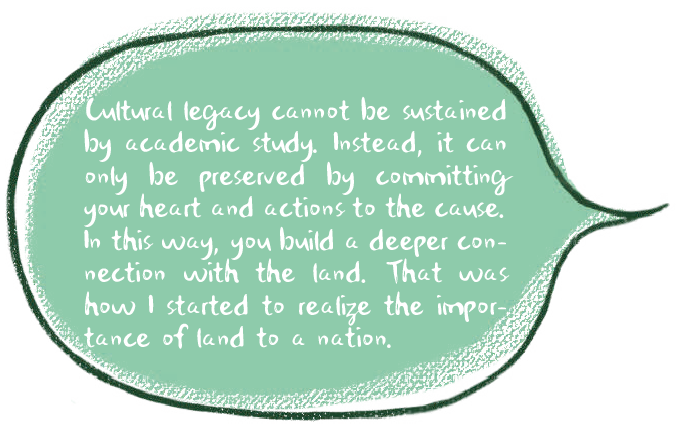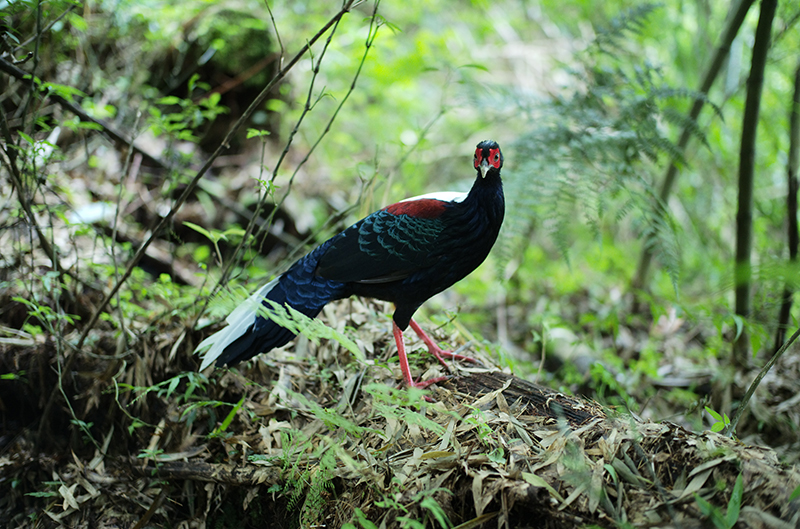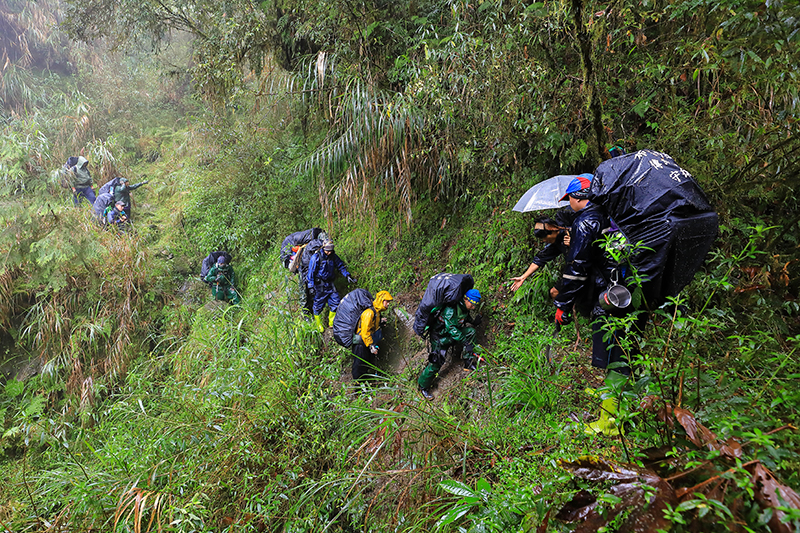Above: Walking on the grassland of Luntaiwen, he took photo of the root-seeking team of Takivatan Bunun youths from behind.

Snow Ram, whose Facebook fan page boasts of nearly 110,000 followers, is currently the most followed mountaineer KOL in Taiwan and also a writer who documents mountains. With his writing and photos, he documents the beauty of the mountain wilderness of Taiwan, describing the cultures, stories and indigenous histories intertwined the landscape.


30-year-old Huang Yu-Xiang is often called by his pen name “Snow Ram”. A mountaineer/ writer/ photographer, Huang has already pocketed 97 mountains out of the One Hundred Peaks in the past 8 years. He shared his experience and thoughts on his Facebook fan page “Vision of a Snow ram”.
His attachment to mountains started as early as the 8th grade. He has suffered from asthma since he was little. In order to build his physical strengh, his family went on hiking trips to the suburban mountains every week. The experience kindled his passion for nature. He was accepted by the Department of Forestry and Resource Conservation, National Taiwan University, his top one choice for university study. About the time of his graduation, his junior classmate proposed a special graduation trip, so they set out for Mountain Jade (Yu Shan), the highest mountain in Taiwan. Several months later, Huang organized another team trip to Jiaming Lake. The breathtaking sapphire blue of the lake inspired his aspiration to set foot on more mountains.

After graduation, Huang was assigned to Dasyueshan National Forest Recreation Area for his alternative military service and he wrote articles in his spare time. “The Truth about the Forest History Your History Class Never Taught” and “Unveiling the Truths about the Six Deadly Vipers of Taiwan” were the first two articles that brought him overnight fame online. In 2015, he took the opportunity and set up his Facebook fan page, taking the word snow from Dasyueshan (Big Snow Mountain) and his own Chinese Zodiac sign ram for the title of his page. Since then, he is gradually known as Snow Ram by the public.

Enjoy Being in the Nature
and Find Joy in the Mountains
Snow Ram is blunt about his once zealous quest for conquering 100 peaks of Taiwan. “At the beginning, I spent all my time on these peaks over 3,000 meters altitude and them only.” From his first climb of Mountain Jade in September 2013 to the beginning of 2016, he climbed nearly 50 of the 100 peaks of Taiwan in just two and a half years. Around 2017, the number of his Facebook subscribers exceeded 50,000. Snow Ram began to receive talk invitations, but he suddenly realized, “I only talked about those mountains over 3,000 meters. There are so many mountains in Taiwan, but I only talked about those furthest away from everyday life. I was not familiar with those hills surrounding our living environment.” After that, Huang gradually expanded his footprints to mid-altitude mountains and suburban mountain hiking trials and found different pleasure in this experience.
The magnificent scenery of the high-altitude mountains is breathtaking. However, in contrast with the alpine desolation and solitude, mid-altitude mountains showcase a diversity of forest forms, fauna and flora. “You would see hundreds of living forms which you don’t recognize just in one corner. No matter how hard you try to identify all of them, there is always something you have never seen before. You are surrounded by so many living beings. This is the biggest source of joy offered by mid-altitude mountains.” He continued to explain that there are many easily accessible suburban mountains in Taiwan. You can visit these trails any time you want. “The experience of these suburban hikes is a critical piece of the puzzle to complete the full picture of the mountain landscape.”
The mountains seem to have cast a spell on him and constantly calling for his return. “I love being in the nature. It feels like I am back into the ecosystem and is a part of it. Every mountain hike is an opportunity to spend time alone with mother nature.” He said crisply. This intimacy with nature also reveals to him the historical legacy of Taiwan throug the remaining traces of past forestry activities, historical trails people used to transport supplies in the past and the cultures of indigenous peoples of Taiwan. “The mountains keep our past for us.” He added.
To uncover more fragments of history, he pored over piles of books and historical literature. His shelves teem with books on mountain history, literature and ecology. “You just cannot help but wonder what had happened in the past once you start to study history. And then you just keep digging deeper and deeper.” Every one of his articles is a huge undertaking. He insists on combing through everything and gaining a thorough understanding of the materials first before he uses his writing and photography to show people the unique treasure of Taiwan.

Snow Ram took a photo of the beautiful Swinhoe’s Pheasant, the most popular bird in the middle and low altitude forests upon this lucky encounter on one of his hikes.
More Than Finding One’s Roots
but also to Pass On the Legacy
In November 2020, the experienced mountaineer went deep into the indigenous settlement area for the first time. He was invited by Taiwan’s ancient trail expert Zheng An-Xi to join the root-searching team composed of young people of the Takivatan Bunun group from the Kunuan indigenous community in Hualien. Tulbus Mangququ, who was shortlisted for the Golden Melody Award for Best Aboriginal Singer, was the team leader.
As the result of Japanese colonial policy to relocate the entire indigenous community, the Takivatan Bunun people were forced to leave their ancestral lands in Danda region, Xinyi Township, Nantou County. They migrated to Kunuan, Wanrong Township, Huanlien County along the ancient trail of Guanmen. People of this indigenous community had launched the “returning home trip” of their own accord every year, but had never managed to reach Danda region. In 2018, Wanrong Township Office commissioned Zheng An-Xi to conduct a survey of the traditional territory of Takivatan Bunun group and to take the youths of the community to return to their ancestral lands. After the project, the community even started to restore the trail back to ancestral lands on their own.
In 2020, the community formed two teams and set off from the two ends of the trail, respectively in Hualien and Nantou. The plan was to meet eventually at the valley of Fata’an river. Snow Ram joined the team of Tulbus Mangququ which departed from the Kunuan indigenous community. During the 8 days and 7 nights trek, he felt strongly the bond between indigenous people and forest and earth.
They walked the same stone paved stairs traveled by indigenous predecessors and hiked through traditional territory of indigenous people. Along the way, his indigenous teammates told him about Bunun legends and tales and reminded him the traditional taboos that he must observe. This opened his eyes to the traces left by indigenous ancestors every step of the way. “All these cultures and knowledge can only be preserved through engaging with the land. This is more than going back to one’s roots. This is about preserving cultural legacy. Cultural legacy cannot be sustained by academic study. Instead, it can only be preserved by committing your heart and actions to this cause. In this way, you build a stronger connection with the land. That was how I started to realize the importance of land to a nation.” He said in an earnest tone.

Snow Ram visited the Juniperus Morrisonicola Forest at Cuei-Chih Area in Mt. Shye and took photos of one of the most precious ancient forest.
The Indigenous Wisdom:
Land-Oriented Lifestyle
When the two teams finally met at the bottom of the valley, Tulbus Mangququ led the singing of Macilumah (Weight Bearing Song) in Bunun language. This is the song Bunun hunters used to sing to signal their return on their way back from their hunting trip in the mountains. Their deep and booming singing echoed through the vast valley, calling out to their ancestors a century ago. This is the most heavenly melody to Snow Ram’s ears. “There are many renditions of this song on YouTube, but none of them could reproduce the touching moment I experienced back then.”
Later on, he summarized this 8-day journey on his fan page. “The smell of burning firewood, the elegance of Bunun language and the wisdom of indigenous elders prompted me to realize the this is a ‘hike’ that is unique to Taiwan and truly indigenous and land-oriented. No, it should be described as a ‘life in the mountains’.”
This is only the beginning for Snow Ram who is now a graduate student of the Graduate Institute of Journalism, National Taiwan University. He plans to focus his thesis on Kunuan indigenous community, to write more about indigenous cultures. “In Taiwan, it would be a shame if you are a mountain enthusiast and has never been in the mountains in the companion of indigenous people. Only by building rapport with them in the mountains and measuring the landscape with your own feet, can you truly find the most cherished beauty of the mountains of Taiwan. That is the cultural treasure that captured the heart of legendary naturalist Kano Tadao.” His footnote at the end of his short essay best summarizes the of the priceless wealth of mountains of Taiwan.

The rain made mountain trail slippery, and the Bunun teammates worked together to overcome the dangerous terrain on the Guangfu Forest Trail.




